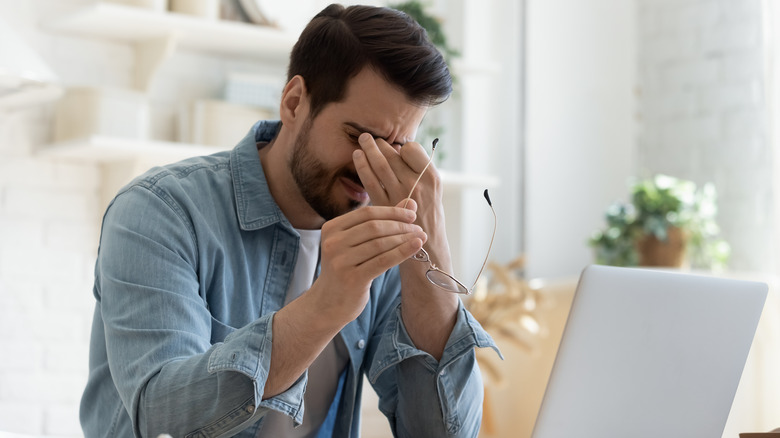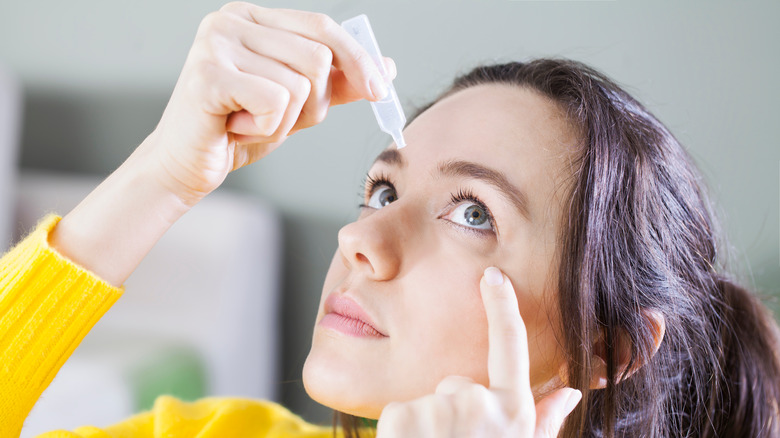The First Thing You Should Do When Your Vision Gets Blurry
Are you finding yourself blinking or squinting to try to see better? When you have blurry vision, it's challenging to see sharply or clearly, according to the American Academy of Ophthalmology. Everything looks out of focus. There are dozens of potential eye diseases or conditions associated with blurry vision, so early detection and treatment for vision problems like blurriness are key.
The first thing you need to do is figure out the cause of your blurry vision. If your blurry vision doesn't go away, gets worse, you have pain, you have an underlying medical condition, or you just want to be safe, get an eye exam. For example, if colors seem faded, you can't see well at night, or you have double vision, you might have cataracts. Treatment may include using brighter lights at work or home, getting a new prescription for glasses or contacts, and finally, surgery (via the National Eye Institute). Aside from cataracts, there may be less serious causes for blurry vision, too, which may only require noninvasive treatment or adjustments in behavior.
Eye strain
Focusing on a task for long periods of time — like staring at a computer screen, driving, or reading — puts strain on the eyes, causing discomfort. The American Academy of Ophthalmology notes that people use eye strain to explain other symptoms such as blurry vision, watery eyes, and headaches. You blink less when you're staring at something for long periods, causing dry eyes and blurriness.
When this happens you should rest your eyes. Blink frequently to keep your eyes from getting dry. The American Optometric Association suggests using the 20-20-20 rule to prevent digital eye strain: Take a break every 20 minutes to look at something from 20 feet away for 20 seconds.
Use artificial tear drops to help dry eyes, and make sure there's no air blowing on your face. Adjust vents so air is blowing elsewhere. You can also use a humidifier to moisten the air. When looking at your computer screen, your gaze should be slightly downward. Your screen needs to be 20 to 26 inches from your face. Adjust your laptop or monitor to meet these rules. If the eye strain persists, see your eye doctor (via the American Academy of Ophthalmology).
Allergies
Eye allergies, also called allergic conjunctivitis or ocular allergies, are common, according to the Allergy & Asthma Specialists of North Florida. You could have seasonal or year-round symptoms from eye allergies, including blurry vision, mucous buildup, watery eyes, itching, redness, and sore eyes. Causes may be attributed to outdoor allergens like pollen, indoor allergens like dust, or irritants like smoke. Over-the-counter medications may help alleviate mild allergies and associated symptoms like blurred vision.
If you have allergies, see an allergist for a skin prick test to figure out what you're allergic to so you can avoid it. Stay indoors during peak pollen times and when it's windy and shower before bed to wash away any allergens on your skin and hair. You may also want to avoid having the windows open at certain hours to prevent pollen from coming inside (via American Academy of Ophthalmology).
Dryness
Dry eyes, caused by not enough tears, can be uncomfortable and cause everything from blurry vision to a burning sensation, per the American Optometric Association. You need tears to keep your eyes healthy to give you clear, sharp vision. There are two main causes of dry eyes: not enough tears or low quality of tears. Tears have three essential components — water, oil, and mucous — and they all provide nutrients and protect your eyes. Medications for allergies, blood pressure, or depression may cause dry eyes. Health conditions such as diabetes, thyroid problems, or rheumatoid arthritis can also cause dry eyes.
The National Eye Institute recommends getting your tears and eyes examined to see if you have dry eyes. Artificial tear drops, prescription or over-the-counter, can help with mild symptoms. You might need prescription eye drops that help you create more tears. There are some things you can do to help with dry eyes, such as wearing wraparound sunglasses outside and taking breaks from screens. Also, drink eight to 10 glasses of water a day and use a humidifier to moisten the air.




